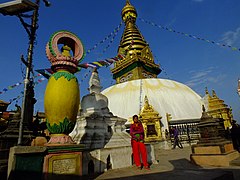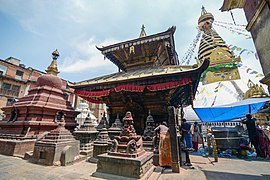Swayambhunath
This article needs additional citations for verification. (June 2022) |
| Swayambhu Swayambhu Mahachaitya | |
|---|---|
स्वयम्भू स्तूप | |
 | |
| Religion | |
| Affiliation | Buddhism |
| Location | |
| Location | Swayambhu, Kathmandu |
| Country | Nepal |
| Geographic coordinates | 27°42′54″N 85°17′24″E / 27.71500°N 85.29000°E |
| Criteria | Cultural: (iii)(iv)(vi) |
| Designated | 1979 (3rd session) |
| Part of | Kathmandu Valley |
| Reference no. | 121bis-004 |
Swayambhunath (
The complex consists of a stupa, a variety of shrines and temples, some dating back to the Licchavi period. A Tibetan monastery, museum and library are more recent additions. The stupa has Buddha's eyes and eyebrows painted on. Between them, the number one (in Nepal script) is painted in the fashion of a nose. There are also shops, restaurants and hostels. The site has two access points: a long staircase leading directly to the main platform of the temple, which is from the top of the hill to the east; and a car road around the hill from the south leading to the south-west entrance. The first sight on reaching the top of the stairway is the Vajra. Tsultrim Allione describes the experience:
We were breathless and sweating as we stumbled up the last steep steps and practically fell upon the biggest vajra (thunderbolt scepter) that I have ever seen. Behind this Vajra was the vast, round, white dome of the stupa, like a full solid skirt, at the top of which were two giant Buddha eyes wisely looking out over the peaceful valley which was just beginning to come alive.[2]
Much of Swayambhu's
Mythology
According to
There are holy monkeys living in the north-west parts of the temple. They are holy because Manjushri, the bodhisattva of wisdom and learning, was raising the hill which the stupa stands on. He was supposed to leave his hair short, but he made it grow long and head lice grew. It is said that the head lice transformed into these monkeys.
Manjusri had a vision of the Lotus at Swayambhu and traveled there to worship it. Seeing that the valley could be a good settlement, and to make the site more accessible to human pilgrims, he cut a gorge at Chovar. The water drained out of the lake, leaving the valley in which Kathmandu now lies. The Lotus was transformed into a hill and the flower became the stupa.
| Part of a series on |
| Buddhism |
|---|
 |

History
Swayambhu is among the oldest religious sites in
However,
Although the site is considered Buddhist, the place is revered by both Buddhists and Hindus. Numerous Hindu monarch followers are known to have paid their homage to the temple, including Pratap Malla, the powerful king of Kathmandu, who is responsible for the construction of the eastern stairway in the seventeenth century.[4]
The stupa was completely renovated in May 2010, its first major renovation since 1921[5][6] and its 15th in the nearly 1,500 years since it was built. The Swayambhu Shrine was re-gilded using 20 kg of gold. The renovation was funded by the Tibetan Nyingma Meditation Center of California, and began in June 2008.[7]
At around 5 a.m. on 14 February 2011, Pratapur Temple in the Swayambhu Monument Zone suffered damage from a lightning strike during a sudden thunderstorm.[8]
The Swayambunath complex suffered damage in the April 2015 Nepal earthquake.[9]
Architecture



The
There are five gilt Buddha shrines at the base of the stupa, all with a Buddha statue inside them. Equally five Tara shrines can be found here, but only four of them are gilt and actually house a Tara statue. The shrine of Vajradhatishori Tara, or White Tara, is empty.[10]

Symbolism
The dome at the base represents the entire world. When a person awakes (represented by eyes of wisdom and compassion) from the bonds of the world, the person reaches the state of enlightenment. The thirteen pinnacles on the top symbolize that sentient beings have to go through the thirteen stages of spiritual realizations to reach enlightenment or Buddhahood.
There is a large pair of eyes on each of the four sides of the main stupa which represent Wisdom and Compassion, known as the Eyes of Buddha. Above each pair of eyes is another eye, the third eye. It is said that when Buddha preaches, cosmic rays emanate from the third eye which acts as messages to heavenly beings so that those interested can come down to earth to listen to the Buddha. The hellish beings and beings below the human realm cannot come to earth to listen to the Buddha's teaching, however, the cosmic rays relieve their suffering when Buddha preaches. Between the two eyes (also called Wisdom Eyes), a curly symbol, symbolizing the nose, is depicted which looks like a question mark, which is a Nepali sign of number figure one. This sign represents the unity of all things existing in the world as well as the only path to enlightenment through the teachings of Buddha.
There are carvings of the Panch Buddhas (five Buddhas) on each of the four sides of top of the stupa, just like there are statues of the Buddhas at the base of the stupa. Panch Buddhas are Buddha in a metaphorical sense in Tantrayana. They are Vairochana (occupies the center and is the master of the temple), Akshobhya (faces the east and represents the cosmic element of consciousness), Ratna Sambhava (faces the south and represents the cosmic element of sensation), Amitabha (He represents the cosmic element of Sanjna (name) and always faces the West) and Amoghsiddhi (He represents the cosmic element of confirmation and faces the north).
Each morning before dawn hundreds of Buddhist (Vajrayana) and Hindu pilgrims ascend the steps from the eastern side that lead up the hill, passing the gilded Vajra (Tibetan: Dorje) and two lions guarding the entrance, and begin a series of clockwise circumambulations of the stupa.



















